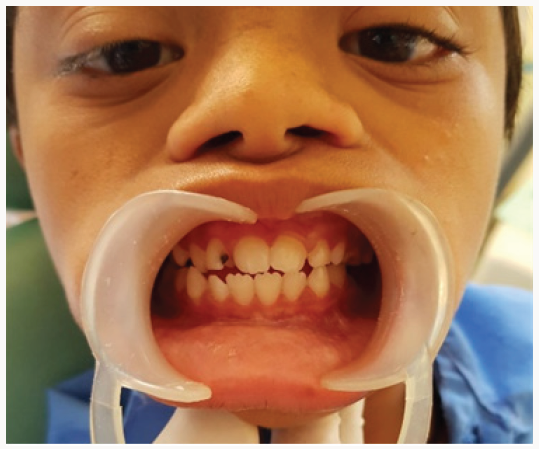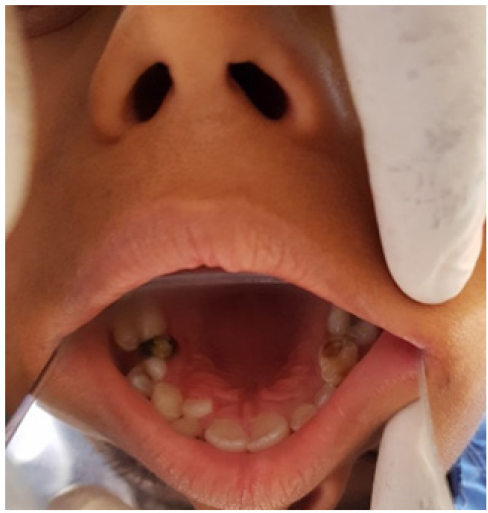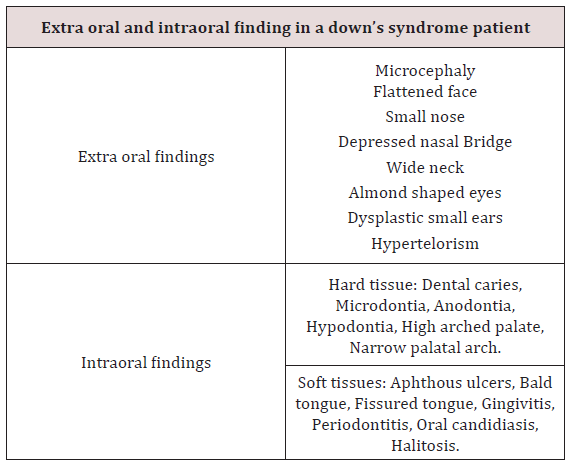Lupine Publishers | Dentistry Open Access Journal
Abstract
Down’s syndrome is the most common syndrome, medical professional
encounters in day to day practice. It is a genetic disorder
with a typical face profile and few classical intraoral features. Herein
we report case and review on Down’s syndrome with facial
features.
Keywords: Down’s Syndrome; Trisomy; Chromosome; Oral Manifestation
Introduction
Down syndrome is one of the commonest disorders with huge
medical and social cost. DS is associated with number of phenotypes
including congenital heart defects, leukemia, Alzheimer’s disease,
Hirsch sprung disease etc. [1]. Down syndrome is a prevalent
genetic disorder in intellectual disability in India. Its prevalence in
tribal population is not known [2]. Down syndrome is one of the
leading genetic causes of intellectual disability in the world. DS
alone accounts 15-20% of ID population across the world [3,4].
Case Report
An 8 year old male patient came to the department of oral
medicine and radiology for routine dental check-up. Extra oral
examination revealed characteristic facial profile with increased
inter canthal distance (Figure 1). Intraoral examination revealed
Gingiva was soft with deposits on the teeth, High arched palate,
with depressed nasal bridge was seen (Figure 2). Macro glossia
was also seen .Correlating the intraoral and extra oral findings a
Provisional diagnosis of Down’s syndrome/ Trisomy 21 was given.
Patient was referred to the respective departments of pedodontics
for restoration of decayed teeth.]
Discussion
Down syndrome is one of the most leading causes of
intellectual disability and millions of these patients face various
health issues including learning and memory, congenital heart
diseases, Alzheimer’s diseases, leukemia, cancers and Hirsch rung
disease. The incidence of trisomy is influenced by maternal age and
differs in population [5,6]. Facial findings in the patients can be
characterised into extra oral and intraoral features (Table 1) [7].
Parents of children with Down’s syndrome should be aware of these
possible conditions so they can be diagnosed and treated quickly
and appropriately. According to Asim A et al. A Down’s syndrome
child should have regular check-up from various consultants. These
include:
a) Clinical geneticist - Referral to a genetic counselling
program is highly desirable.
b) Developmental paediatrician.
c) Cardiologist - Early cardiologic evaluation is crucial for
diagnosing and treating congenital heart defects, which occur
in as many as 60% of these patients.
d) Paediatric pneumonologist -Recurrent respiratory tract
infections are common in patients with DS.
e) Ophthalmologist.
f) Neurologist/Neurosurgeon - As many as 10% of patients
with DS have epilepsy; therefore, neurologic evaluation may be
needed.
g) Orthopaedic specialist.
h) Child psychiatrist - A child psychiatrist should lead liaison
interventions, family therapies, and psychometric evaluations.
i) Physical and occupational therapist.
j) Speech-language pathologist.
k) Audiologist.
l) Paediatric dentist.
Hackshaw AK et al in their study, proposed a new screening
method in which measurements obtained during 1st and 2nd
trimester are integrated to provide the risk status of having
pregnancy with DS. Moderate to severe intellectual disability occur
as a constant feature, with IQ’s ranging from 20 to 85 [8]. Kennard
in his review stated that there are a number of ultrasound markers
in Down’s syndrome which includes nuchal fold thickness, cardiac
abnormalities, duodenal atresia, femur length & pyelectasis [9].
The signs and symptoms of Down’s syndrome are characterised
by neotenization of brain and bodies. Management strategies
such as early childhood intervention, screening from common
problems, medical treatment when indicated, a conductive family
environment and vocational training can improve the overall
development of children with Down’s syndrome [10].
Conclusion
Genetics have always have played a major role in physical
and mental being of an individual. Downs patients being mentally
and medically weak, best care needs to be taken with adequate
precautions.
Read more Lupine
Publishers Blogger Articles please click on: https://lupinepublishers.blogspot.com/
Read more Dentistry Open Access Journal Articles please click on: https://lupine-dentistry-oral-health-care.blogspot.com/




No comments:
Post a Comment